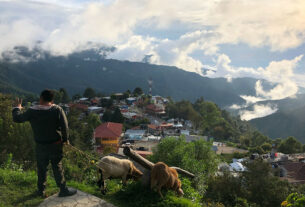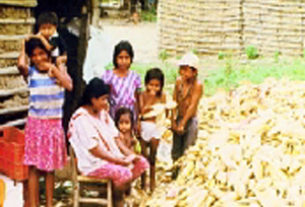Did You Know…?
The city of Los Mochis (“Mochees”, as locals call it) in the northern state of Sinaloa, is one of Mexico’s newest cities. It dates back only as far as 1872, when a U.S. engineer, Albert Kimsey Owen (1847-1916) arrived. Owen envisaged the city as a U.S. colony centered on sugar-cane production in this previously unsettled area and the terminus for a railway across the Sierra Madre Occidental.
Owen had been raised in New Harmony, the city founded by Robert Owen (no relation) and decided to try and found a similar “ideal socialist” city somewhere in Mexico. In 1868 he visited Veracruz, but failed to find a suitable location. In 1871-1872 he visited Chihuahua and Sinaloa and decided that the site of present day Topolobampo was ideal for his purposes. He founded the Texas, Topolobampo and Pacific Railroad and Telegraph Company (later the American and Mexican Pacific Railroad) and in 1881 was granted the concession for the settlement of a town to be called Ciudad González.
Owen then launched a company called The Credit Foncier of Sinaloa, and issued 200,000 bonds to be sold at ten dollars each. Half the proceeds were intended to pay for the railway, half for the new city. Settlement began in October 1886. Two and a half years later, in April 1889, the first large group of colonists – 300-strong – set sail from New York, arriving in Sinaloa in July – only to find a deserted beach and no Owen. Owen had returned to the U.S. but finally arrived the following year with another 30 colonists. During 1891, 70 more settlers arrived. They founded various settlements including Vegatown (Estación Vega), La Logia, El Público and El Platt. They dug an irrigation canal, 12 kilometers long, to divert water from the Fuerte River across their lands and busied themselves preparing everything for large-scale cultivation. But problems abounded and despite their heroic efforts, the project was derailed. During 1892, more than 200 left, disillusioned as a result of the hard work, hunger and disease. In November 1893, Owen finally abandoned the project. Most of the 1200 norteamericanos who had visited or tried to make a living in the area returned home.
An amazing visual record of these years is housed in the Henry Madden Library of the California State University, Fresno. This fantastic collection of early photos, some dating back to 1889-90, was taken by Ira Kneeland, one of the first settlers, and can be viewed on the library’s webpages.
Meanwhile, in 1893, another American, from Virginia, Benjamin Francis Johnston (1865-1937) founded the Eagle Sugar Co. (Compañia Azucarera Aguila S.A.) and constructed a factory, church, dam, and the Memory Hill lighthouse. Ten years later, in 1903, Johnston officially founded Los Mochis. The town’s name means place of the land turtles.
Johnston, who came to own more than 200,000 hectares, built a veritable palace (including a banquet kitchen, indoor pool and even an elevator, one of the first in the country) for his residence in the town. The mansion had lavish furnishings and was surrounded by a huge garden, full of exotic plants – which later became the city’s botanical gardens, Parque Sinaloa. During the Mexican Revolution, Johnston, owner or part-owner of no fewer than 22 companies, even printed his own money. Sadly, Johnston died in 1937 (in Hong Kong) and his family returned to the U.S.; the house was later torn down and the area redeveloped for a shopping plaza.
The motives of both Owen and Johnston have been questioned by many historians who view their efforts as being more akin to capitalist expansion and neo-imperialism than any form of socialism. Owen’s projects, they argue, could have resulted in the annexation of a million square kilometers to a U.S. which had ambitious ideas of expansion at the time. Owen has been labeled variously a visionary, a madman or a conman and fraudster. Similarly, Johnston has also been regarded by some as a stooge for grandiose U.S. expansionist plans.
Whatever the motives of their founders, both Topolobampo and Los Mochis are highly unusual in Mexico in that they are “new towns”, without any colonial or pre-Hispanic antecedents. Los Mochis became especially important in the second half of the twentieth century as a major commercial center, marketing much of the produce grown on the enormous El Fuerte irrigation scheme. A large proportion of this produce is exported to the U.S. via the famous Copper Canyon railway. Los Mochis is the passenger terminus at the western end of the railway line. For freight, the line continues to the town’s port, Topolobampo, “the lion’s watering place” or “tiger’s water”. The port occupies one of Mexico’s finest natural harbors, the head of a drowned river valley or (in geographic parlance) ria, which affords an unusually high degree of security in the event of hurricanes. Topolobampo has a shrimp-packing plant and all the normal dockside installations.
Both Los Mochis and Topolobampo have become important centers for tourist deep-sea sport fishing, especially for swordfish and sailfish. A nearby beach, Maviri offers superb white-sand beaches and calm, safe water for swimming and water-sports, but is scheduled for future development as a tourist resort. These plans have existed for years… Mmmm, maybe mañana…
This article is the basis for Chapter 16 in the author’s Mexican Kaleidoscope: myths, mysteries and mystique (Sombrero Books, 2016).


